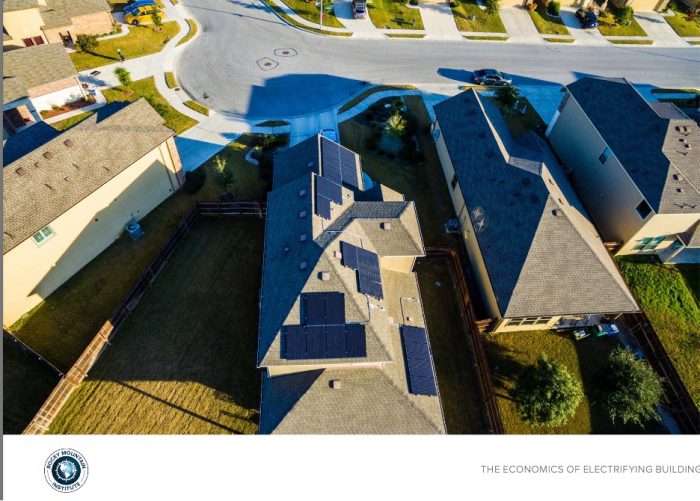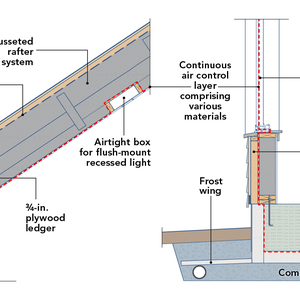
A recent issue of the Canadian trade magazine Better Builder started with a publisher’s note by John Godden titled “Understanding the law of diminishing returns.” In the note Godden wrote:
“Where does the law of diminishing returns kick in? Ironically, the most popular programs—like Net Zero or Passive House—were conceived before we started accounting for embodied carbon. Net Zero marketing focuses on reducing operational carbon at the expense of using more embodied carbon to build those homes. Building components like triple-glazed windows, certain types of insulation, and concrete can also negate these emission reductions. Early experiences show that electric [net-zero-energy] houses cost more to operate. Where is the sweet spot? Is net zero a reasonable goal? Time will tell.”
Godden’s argument would have more potency if the industry actually cared a whit about embodied carbon instead of using it as an excuse to avoid doing much of anything about energy efficiency. It could, as I noted in Benefits of Simple Building Forms, change the designs of homes. If the industry were worried about the embodied carbon of triple-glazed windows, designers/builders could make houses smaller and use fewer windows more strategically. But they don’t; they keep building the same house.
Design and upfront carbon emissions
The refusal of builders to accept that designs must change if we are going to reduce our upfront and operating carbon emissions was made obvious to me on Earth Day, when a major North American builder touted their green credentials with an optional “Net Zero Home” package developed by the Canadian Home Builder’s Association (CHBA). The client paid $60,000 extra (a lot of money) for a 4400 sq. ft., “net-zero ready” home with a handful of performance upgrades that included an insulation package of R-10 insulation under the slab, R-32 insulation in the walls, R-40 spray foam insulation on “exposed floors”; triple-glazed windows; and a dual-fuel air-source heat pump. Airtightness measured 1.0 ACH50.
Photos on the CHBA website show a brick facade with bumps, jogs, and bays that likely create thermal bridges; a living room with a wall of glass looking into the neighbors’ houses; and a six-burner, professional-grade gas range in the kitchen. The “ready” in the program means that solar panels can be added to the roof, but the complexity of the roof design probably makes it close to impossible to do well. There is no mention of upfront or embodied carbon.
There is a better way
 Refusing to change how we design means that we are trapped in a world where every decision about reducing operating carbon simply means we are adding embodied carbon and expense. It doesn’t have to be this way.
Refusing to change how we design means that we are trapped in a world where every decision about reducing operating carbon simply means we are adding embodied carbon and expense. It doesn’t have to be this way.
A decade or so ago, I visited Philadelphia and toured the simple and gutsy houses built by Postgreen Homes and designed by Interface Studio Architects (ISA). Nic Darling, then a partner, explained how they built simple, small, and boxy houses that were affordable and made green by “not polishing a turd.” He said:
“‘Turd’ is, maybe, an unnecessarily rude word to use to describe what are often pretty nice homes, but the concept is sound. Most of the builders and developers reporting high premiums for pursuing LEED are still trying to build the exact same home they have always built. They are simply adding features to make that same house energy efficient, healthy, and sustainable. This addition gets expensive. So, they polish the turd. Rather than redesign the house that has been successful for them in the past, they add solar panels, geothermal systems, high-end interior fixtures, extra insulation, and other green features. The house gets greener. It gets certified, but it also increases significantly in cost. Since the features are add-ons and extras, the price rises as each one is tacked on.”
Keep it simple for low-loads and low carbon

Darling wrote about the phenomena of “polishing a turd” before upfront carbon was on the radar but his point is even more valid now. All this talk about “diminishing returns” for adding more insulation or triple-glazing is just a new excuse for not having to change our way of doing business, which currently is all about adding more stuff and charging more money for it. What we have to do instead, as noted in previous posts includes:
- Start with simple forms: When we complicate designs, not only do we add costs, we also complicate insulation, air sealing, mechanical layout, and many other aspects of construction. Simple forms eliminate thermal bridges and allow us to get the most bang for our insulation buck.
- Use less energy: One of the ways electrification will succeed is through energy efficiency, and we can design and build low-load homes with products that have low upfront carbon like cellulose and wood fiber insulation.
- Optimize window size: Windows are high in upfront carbon and cost a lot of money. Good design uses them sparingly, and in places and sizes where they make the most impact on the building, for light, views, and appropriate solar heat gain.
- Design for PV: Roof design and orientation matter because you can’t be net zero ready if there is a complicated roof without enough area facing south.
Lloyd Alter is a former architect and developer. His journalism career includes 15-plus years as design editor at Treehugger.com. Today he teaches sustainable design at Toronto Metropolitan University. His work can be found at Carbon Upfront.
Weekly Newsletter
Get building science and energy efficiency advice, plus special offers, in your inbox.















7 Comments
I don't disagree with anything in this piece, except that when I think of diminishing returns, I think more about whether R 100 ceilings are enough better than R 49 or 60, to justify the extra cost in money or carbon.
You're ranting and railing against the wrong people in this article. Builders and the building
industry don't ignore these problems from preference- They attempt to meet the desires
of their clientele (the entire population). Let's face it, the overwhelming majority of the
population knows essentially nothing about embodied carbon or energy efficiency in housing.
You want to fix the problem - Educate the public! If we were all engineers and climate
scientists we wouldn't have these problems (or a multitude of others for that matter) but
given the general education level (here and worldwide) I suspect the building industry isn't
all that bad.
Sure, educate the public.
As a member of the (more) educated public, I'd pressume that many folks do know what shows up knocking on doorsteps in the form of utility bills. Reducing someone's utility bill may keep them ignorant of embodied carbon or details of energy efficiency, but they can still participate indirectly. I know a bit or two just from GBA and even more from a "green" architect who became a friend. It still took some motivation on my part and being selective as a consumer of the building profession. The process could be easier if everything refers back to what the public does know about, like $/kwh and CO2 footprint.
For example, HVAC professionals I've hired still oversize units. Maybe a few hinted to me to better insulate my home as well but in the end that's not their job; and besides, their newer units "save money" anyways -- as they always say :D. (I must note something that GBA folks have talked about -- that no HVAC person has ever even offered to run a Manual J on any of my homes either.) So the homeowner is expected to then go talk to an insulation professional. The insulation guy arrives at my home to give me options on blown in or sprayed in, and sealing up seams, etc. Maybe they bring an IR camera to show me where my home is missing cold and drafty. They make a claim that a sealed & insulated home doesn't need as much cooling / heating, but it's hard for them to give more than a guessimate of my future bill without working with details from the HVAC guy. And it's up for me to hire someone else to figure out exactly how leaky my home is. So I hire yet another person to do the blower door test ... on and on this list of professionals goes. If I do the suggested 2-3 bids per job for an all-in-one build or retrofit, then me, the homeowner, end up juggling almost a dozen professionals just to make my lower carbon home happen. A GM (general manager) could do it for me but even then my architect friend reminded me that many GMs have their goto contractors know might know about energy efficiency but don't push for it getting done. I could end up with new house wrap but no detail around windows or doors. So if I hand over the keys to a GM, my carbon goals might just be out the window unless I micro-manage the professionals anyways (and that begs the question: why the GM?!) My point is: there is some industry consistency and streamlining needed that an even educated public can't help with.
If I want to work with a single professional with the ask: "I want my home's carbon footprint to be cut in half" who could get that done? I'm sure several people on GBA would do a great job. But like you said, it's kind of preaching to the choir. I'd need someone licensed in my State, who can get permits from my County, knows which local contractors actually can do blower door tests, etc. I know one local person who could pull the industry together for me, they retired, and they're trying to get the NextGen involved in our community.
Builders, fix zoning if you're serious about either affordability or emissions!
Paul,
Our provincial government here in BC has recently embarked on an interesting policy experiment. In an attempt to solve the affordability and scarcity problems with housing, they have identified a number of local areas they feel are restricting multi-family building, and have threatened to up-zone them if they don't start pulling their weight. I guess we will see how that works out.
The issue is that it takes many years. We forgot how to build affordable and efficient housing for several decades.
Provincial is right.
Log in or create an account to post a comment.
Sign up Log in